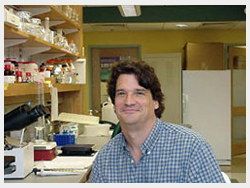Silvio O. Conte Center
Projects and Cores > Project 1
Project Leader: Douglas Coulter
Recent evidence has emerged to indicate that vesicular neurotransmitter content is dynamically and autonomously regulated at inhibitory synapses. Vesicles do not have a static pool of neurotransmitter, as previously believed. Instead, the content of vesicles varies on a minute-to-minute basis as a direct consequence of the amount of cytoplasmic neurotransmitter available to be packaged. This in turn depends on several factors, including the activity of uptake transporters and also on the amount of available precursors for local GABA synthesis. Since inhibitory efficacy is a prime determinant of the net excitability of synaptically interconnected neurons, activity-dependent reductions in GABA vesicle content is in a pivotal position to devalue the fundamental currency of synaptic transmission, the level of postsynaptic receptor activation by release of a single quanta. Given the critical role played by GABA release in regulating brain function, we are characterizing the critical factors regulating vesicular GABA content. This is being accomplished in experiments focused on two specific aims:
- AIM 1. Determine the relative importance of the glial and neuronal neurotransmitter transporters in regulating inhibitory synaptic vesicle content under high activity conditions.
- AIM 2. Identify the primary intercellular messengers and intracellular intermediaries regulating recruitment of more robust glial neurotransmitter recycling at inhibitory synapses during periods of high activity.
We are examining GABA and glutamate uptake by glia and inhibitory synaptic boutons and glutamate-glutamine cycling by glia, as these processes affect vesicular GABA levels. This is being assessed by monitoring GABA release through recordings of IPSCs in postsynaptic neurons, as well as by recording glial glutamate and GABA transporter currents in response to synaptic stimulation. We are integrating patch clamp recording techniques, pharmacology, laser uncaging of neurotransmitters and effectors, and molecular biological techniques to elucidate mechanisms regulating vesicular GABA content. The Conte Center environment affords us a unique opportunity to address these questions. Access to transgenic animals with engineered glia, unique transfection vectors targeting glia, MNI caged GABA and glutamate amenable to high resolution two-photon uncaging experiments, and assessment of local production and regulation of proteins in neuronal processes are all critical to conduct of the proposed experiments.


